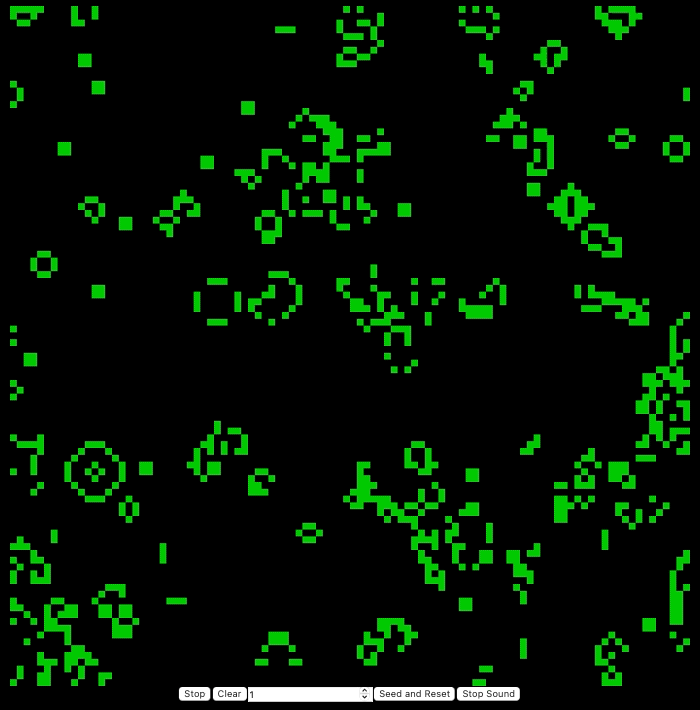Life and Games and Games Of Life
So I made a thing, my own little
implementation of Conway’s Game of Life.

You can tinker with the state, creating glider guns to your heart’s delight, and even hear the state of the game by musical notes. Now I knew I wanted to write a post about having made it, but in all honesty, the first questions that jumped to my mind were “Why? So what?”. I love Conway’s Game of Life in its own right, for what it tells us about real life and the mesmerizing patterns emerging from simplicity, but that negative question made me realize I had more to say, and so I’ll cover both. Let’s talk about why I made this, and why I love it.
Let’s Get Motivated!
Questioning why I should work on a project is a frequent occurrence for me. If you’re like me, and alternate between nervous feet shuffling because you can’t think of a single project, and then being overwhelmed by the sheer number of ideas which appear out of thin air the next day, then it probably feels pretty natural to ask that sort of question. The added pressure of doing “portfolio” projects - i.e. projects for public, résumé consumption - can send your mind off the creative track, as every idea gets reduced down to “what could this do for my career?”
Now, for as much as I would like to routinely put on my TensorFlow spandex outfit (wait you don’t have one?) and channel my inner, deep learning Richard Simmons for a personal project, I’ve come to learn a bit about what drives me to do projects. The first criteria might sound obvious or cliche, but maybe doesn’t get vocalized enough: I need to love the project, need to see it come to life and work. That is absolutely not to say that deep learning doesn’t fall under that criteria, but whereas I might want to work with GANs and I’m planning on doing so for my next project, just forcing myself to just go implement a random paper or go try a different normalization or activation function, for the heck of it, doesn’t get me bouncing out of bed.

But that’s just one criteria: another aspect I find feeds my inner programming demons is the satisfaction that comes from building something pretty much from scratch, as I’ve done with game and simulation projects. The “low code” nature of a lot of basic ML / deep learning projects can leave you feeling more like the monkey who knows how to turn the knobs for good treats, rather than the flannel-clothed craftsman-engineer-lumberjack(?) I imagine myself to be. Yet, there is also the serious allure of doing projects which have nothing to do with your other preoccupations, making programming your staycation. If I’m working on getting segmentation networks to run on a robot (I am), and I’m dealing with all sorts of Docker and Conda hell to do so (oh, I am), then escaping to make a little simulation is a relief.

Finally, it is strange to realize this, but I have spent so much of my programming life making programs which output text, a ML model, or perhaps processed images or plots, but very little in the way of highly visual, interactive programs. My inner curiosity and quest for graphics-driven neuron stimulation has gotten the better of me, and for fun I would like to here and there make more graphically driven programs which use AI in the background, as with game AI or reinforcement learning visualizations. Ideally, these would be easy to share with others, and the framework I would use would be simple but robust. The wonderful videos of Daniel Shiffman on YouTube - imagine the Mr. Rogers of programming - introduced me to the p5.js library, which checks off all of those criteria, and got me really inspired to make some visual programs. And if you’re going to start tinkering with graphics, you might as well start small, and implement a classic…
Conway’s Game of Life
You know what I’m going to say here right?
Stares excitedly and expectantly…
Eyes narrow…
Really?!
Jokes aside, I do find it funny that more people don’t know what Conway’s Game Of Life is…though to be fair I had only ever heard of it in passing and was never shown it in my computer science studies, when it really should be a “Hello, World!” for graphics programming. The Wikipedia page on it is quite jam-packed with the history and details, which I won’t repeat here, except to make a quick summary and couple of significant points.
To summarize, it is a “zero-player” “game”, meaning that it is really more of a simulation, where the user/player only has any influence in the initial setup of the environment state. This simulation is conducted, generally, on a form of grid and this grid contains either live or dead cells. Once an initial configuration of which grid cells contain life is provided, a simulation can proceed according to a few basic rules about where life will live on, be created, or die out, based on how many live cells are in a small neighborhood. There are many derivatives and variations of this, notably the work done by Stephen Wolfram on the 1-dimensional analog of these cellular automatons, but the original concept was invented by British mathematician John Conway in 1970. It is easy to forget in the modern landscape of ever changing software, that computer science has long, deep historical roots, but this really is a classic, and my dual loves of computer science and history have left me spending fair amounts of time absorbing things like this…and arcane info about early personal computing, such as with the Commodore PET.
So we’ve got a case of some cool history on our hands, so what? Well I mentioned it’s really a form of simulation, and not only do we all need a break from the one we’re living in, but simulation is a really fun, exciting and under-appreciated field of study with major potential for real-world planning and optimization. My last course in my CS Master’s focused on simulation, and while the probability and statistics material can be a steep learning curve, if you’ve ever felt the thrill of playing God in Rollercoaster Tycoon or Sim City, you’ll quickly find yourself drawn into the deep end. In fact a quick Google search will show you that the game is specifically considered an early form of agent-based simulation (shameless plug: if you’re interested in that kind of simulation, check out my simulation of outdoor cats in an urban area).
Admittedly, I have not researched this categorization, but at least 2 characteristics do stand out from other such simulations. First, all updates to the “agents” (e.g. cells) are performed in parallel, whereas typically you must apply updates to agents one at a time, and because these updates will be affected by the presence of other agents, the order in which you apply these updates is important. Second, the idea of “agency” here is a little weaker than you might expect, as there is only the application of general rules and no agent decision making per se, but then again, this bears similarity to how you might conduct a simulation of disease spread over a geographic area.
Last, but certainly not least - in fact, I was really saving the best for last - Conway’s Game of Life, evidences miraculous emergence of patterns, from the humble stable patterns (like 2x2 blocks), to oscillating patterns, and beyond. If you’re scratching your head asking, “so what?” consider that, while higher level patterns are likely to be ephemeral in randomly initialized games, the existence of these patterns alone tells us two major things, one regarding computation, and one regarding life. The first, is that, believe it or not, Conway’s Game of Life is Turing complete: in English, that means that given the right setup, the game can simulate a Turing machine, which is in turn capable of simulating the computer you are reading this on. So the next time your Windows OS decides you have no say over updates, and that your graphics drivers should again be reset to out of date drivers, take comfort in the idea that it’s really more of a natural pattern.
The second follows from the fact that you can have such a simple environment and set of rules yield the ability to perform the same computations your computer can make. That is because if we continue to believe that computers can one day simulate the same reasoning and life we ourselves exhibit, then we are really looking at the creation of life from two basic ingredients (live/dead cells) under the right conditions (the rules of the game). Suddenly the notion that we might find life in the universe, where we have the right chemical ingredients, such as carbon, under favorable conditions like temperate liquid water, doesn’t seem so far fetched. Whether you examine this as a wonder of the physical world, or as evidence of the divine, there is no denying there is great beauty here, and a lot more than meets the eye.
Now it’s time to take the red pill, see how deep the rabbit hole goes, and run some simulations…
References
Wikipedia contributors, “Conway’s Game of Life,” Wikipedia, The Free Encyclopedia, https://en.wikipedia.org/w/index.php?title=Conway%27s_Game_of_Life&oldid=1187705341 (accessed December 15, 2023).